|
|
|
Sort Order |
|
|
|
Items / Page
|
|
|
|
|
|
|
| Srl | Item |
| 1 |
ID:
163914
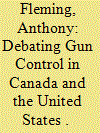

|
|
|
|
|
| Summary/Abstract |
The weakness of the antigun lobby in the United States is attributed to the “collective action problem” of trying to mobilize “free riders” behind a public purpose. But the Coalition for Gun Control emerged in Canada to successfully lobby for the Firearms Act of 1995. If the “collective action problem” is not limited to the United States, then are its effects “mediated” by political culture? To address this research question, we content analyze (1) media coverage, (2) party platforms, (3) presidential, and (4) ministerial rhetoric. Three frames represent “restrictive” gun policies that ban or regulate firearms, “punitive” gun policies that penalize the person for the unlawful use of firearms, or “lenient” gun policies that encourage gun ownership and gun rights. Marked differences in framing the gun debate help explain why an antigun coalition emerged in Canada but not the United States.
|
|
|
|
|
|
|
|
|
|
|
|
|
|
|
|
| 2 |
ID:
186871
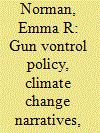

|
|
|
|
|
| Summary/Abstract |
At the time of writing this Editor's Note, it has been but a few weeks since the horrifying school shooting in Uvalde, Texas on May 24, 2022, that killed 19 children and two teachers, and the supermarket massacre of ten people in Buffalo, New York ten days earlier. Both lone gunmen were 18 years old and both used legally acquired AR-15-style weapons (Edmondson 2022). The events catapulted gun control debates again into the headlines and culminated in swift legislation proposals in Congress. On June 8, 2022, a bitterly divided House—voting largely along party lines—approved a stricter gun control bill package by 223 to 204 votes but also revealed the partisan chasm that continues to afflict passing effective firearms control legislation in the United States. Among other things, the bill would ban under-21s from legally purchasing semiautomatic rifles, increase requirements for gun storage in private households, and prohibit the sale of magazines holding over 15 rounds (Edmondson 2022). The acrimonious arguments in the House were predictably partisan with Democrats focusing on protecting children from gun violence while Republicans highlighted that the proposal would violate Second Amendment rights. Representative Jim Jordan (R-OH; cited in Edmondson 2022), opined that protecting children “is important—it sure is. But this bill doesn't do it. What this bill does is take away Second Amendment rights, God-given rights, protected by our Constitution, from law-abiding American citizens.”
|
|
|
|
|
|
|
|
|
|
|
|
|
|
|
|
| 3 |
ID:
163913
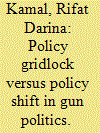

|
|
|
|
|
| Summary/Abstract |
Why do major events of gun violence (i.e., mass shootings) lead to incremental change or no federal legislative change at all in the United States while major events of gun violence have resulted in large-scale legislative changes in Canada? Exploring the complexities involved in this compelling question, this article conducts a comparative analysis of recent gun control policy gridlock and shift in these two countries. We concentrate on two mass shooting cases in each country: the Columbine (1990) and Sandy Hook (2012) massacres in the United States and the École Polytechnique Massacre (1989) and Concordia Shooting (1992) in Canada. We use veto player theory to gain insights into why tightening gun policy is so difficult to implement in the United States while Canada often follows up with policy transformations after a focusing event. This theory informs the central argument that the key factors underpinning the divergent policy outcomes on gun control issues in both countries involve differences in the structure of government/institutional design and the role and power of interest groups in each case.
|
|
|
|
|
|
|
|
|
|
|
|
|
|
|
|
| 4 |
ID:
071212


|
|
|
|
|
| Publication |
Geneva, United Nations, 2003.
|
| Description |
xiii, 224p.
|
| Series |
UNIDIR/2002/20
|
| Standard Number |
9290451475
|
|
|
|
|
|
|
|
|
|
|
|
Copies: C:1/I:0,R:0,Q:0
Circulation
| Accession# | Call# | Current Location | Status | Policy | Location |
| 046199 | 355.824/UNI 046199 | Main | On Shelf | General | |
|
|
|
|
| 5 |
ID:
054525
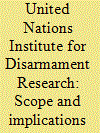

|
|
|
|
|
| Publication |
Geneva, United Nations Publications, 2002.
|
| Description |
xiii, 224p.
|
| Series |
UNIDIR/2002/20
|
| Standard Number |
9290451475
|
|
|
|
|
|
|
|
|
|
|
|
Copies: C:1/I:0,R:0,Q:0
Circulation
| Accession# | Call# | Current Location | Status | Policy | Location |
| 046196 | 355.824/UNI 046196 | Main | On Shelf | General | |
|
|
|
|
| 6 |
ID:
121045
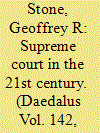

|
|
|
|
|
| Publication |
2013.
|
| Summary/Abstract |
How does the Supreme Court serve the "common good"? What is the Court's responsibility, as the ultimate interpreter of the Constitution, in our constitutional system of government? This essay explores that question with an eye on the recent performance of the Court in highly controversial and divisive cases. What explains the Court's decisions in cases involving such issues as campaign finance regulation, gun control, abortion, affirmative action, health care reform, voting rights, and even the 2000 presidential election? This essay argues that there is a right and a wrong way for the Supreme Court to interpret and apply the Constitution; and whereas the Warren Court properly understood its responsibilities, the Court in more recent decades has adopted a less legitimate and more troubling mode of constitutional interpretation.
|
|
|
|
|
|
|
|
|
|
|
|
|
|
|
|
| 7 |
ID:
144087


|
|
|
|
|
| Summary/Abstract |
If a government is facing an armed uprising, why doesn’t it confiscate all privately owned weapons? When and where is forcible disarmament most likely to occur? Can forcible disarmament reduce rebel activity? To establish a monopoly on the use of force, a government must either convince its citizens not to rebel, or remove their capacity to do so. Existing literature has left this choice – between punishment and disarmament – virtually unexplained. Most existing research focuses on disarmament in the context of post-conflict stabilization, rather than forcible disarmament during war. I introduce a mathematical model of irregular warfare, in which government and rebel forces seek a monopoly on violence. The model shows that disarmament occurs mainly in ‘hard cases’, where otherwise strong governments are unable to punish opponents or reward supporters. I test these claims with declassified archival data on counterinsurgency in the Soviet North Caucasus. The data confirm that disarmament was most likely where the government’s coercive leverage was limited – due to poor intelligence and potential backlash from collateral damage. In these otherwise challenging circumstances, disarmament significantly reduced rebel violence – short-term and long-term, locally and region-wide. By limiting the potential coercive resources under the opposition’s control, disarmament can render rebels unable to sustain a campaign of violence against the state.
|
|
|
|
|
|
|
|
|
|
|
|
|
|
|
|
|
|
|
|
|